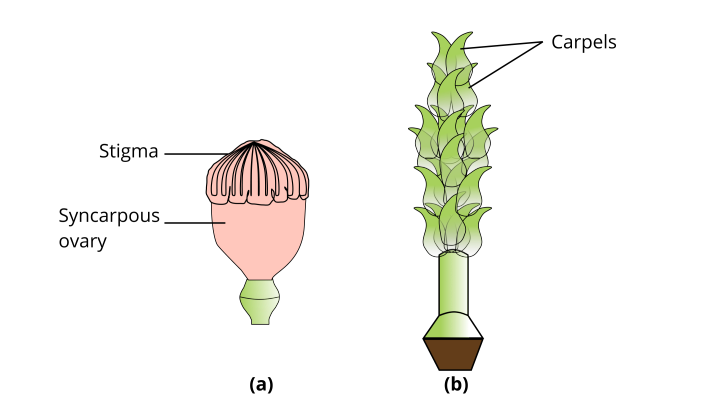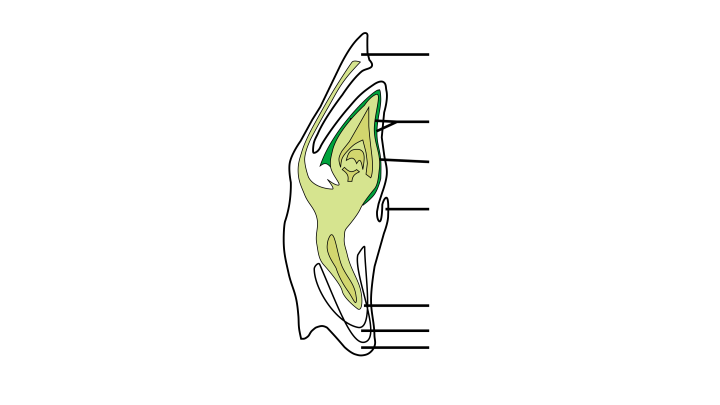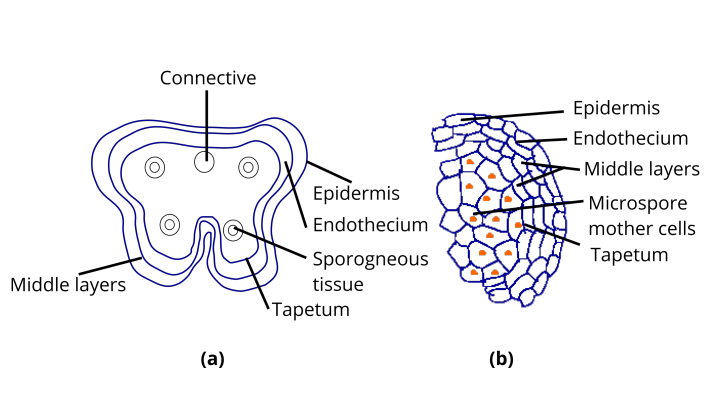NCERT Exemplar for Class 12 Biology - Sexual Reproduction in Flowering Plants - Free PDF Download
Free PDF download of NCERT Exemplar for Class 12 Biology Chapter 2 - Sexual Reproduction in Flowering Plants solved by expert Biology teachers on Vedantu.com as per NCERT (CBSE) Book guidelines. All Chapter 2 - Sexual Reproduction in Flowering Plants Exercise questions with solutions to help you to revise complete syllabus and score more marks in your Examinations.
Access NCERT Exemplar Solutions For Class 12 Biology Chapter 2 - Sexual Reproduction In Flowering Plants
Multiple-Choice Questions
1. Among the terms listed below, those that are not technically correct names for a floral whorl are:
i. Androecium
ii. Carpel
iii. Corolla
iv. Sepal
a. i and iv,
b. iii and iv
c. ii and iv
d. i and ii.
Ans: Correct option is c.
Carpel and sepal are individual parts and make gynoecium and calyx respectively. The other two terms Androecium and corolla refer to an entire region containing gynoecium, androecium, corolla, and calyx. These, therefore, can be used for the floral whorls. These, respectively, are made by carpels, petals, and sepals.
2. The embryo sac is to the ovule as ___ is to an anther.
a. Stamen
b. Filament
c. Pollen grain
d. Androecium
Ans: Correct option is c.
Embryo sac is present in one ovule, while pollen grains are present in another. The female gametophyte is the embryo sac for which the ovule is the megasporangium i.e., it contains the female gametophyte or embryo sac. Similarly, the pollen grain being the male gametophyte resides in the microsporangium i.e., the anther. This establishes that what embryo sac is to ovulate, the pollen grain is to another in a flower.
3. In a typically complete, bisexual, and hypogynous flower the arrangement of floral whorls on the thalamus from the outermost to the innermost is:
a. Calyx, corolla, androecium, and gynoecium
b. Calyx, corolla, gynoecium and androecium
c. Gynoecium, androecium, corolla, and calyx
d. Androecium, gynoecium, corolla, and calyx
Ans: Correct option is a.
As we go from outer to inner arrangement in a floral whorl on the thalamus of a flower, we encounter calyx, corolla, androecium, and gynoecium. The flower in angiosperms has four floral whorls namely, calyx, corolla, androecium, and gynoecium constituting it. The outermost whorls are the accessory or the helping whorls as they do not directly contribute to reproduction in the plant. The accessory whorls contain calyx and corolla. Female and male parts of the flower, which are directly involved in reproduction are gynoecium and androecium respectively. These are the inner whorls. Therefore, a correct arrangement would correspond to the one given in option a.
4. A dicotyledonous plant bears flowers but never produces fruits and seeds. The most probable cause for the above situation is:
a. Plant is dioecious and bears only pistillate flowers.
b. Plant is dioecious and bears both pistillate and staminate flowers.
c. Plant is monoecious
d. Plant is dioecious and bears only staminate flowers.
Ans: Correct option is d.
A pistillate flower is the one which contains pistils only and the staminate flower contains stamens only. Hence, a dicotyledonous plant which bears flowers but does not make fruits or seeds must be dioecious and have staminate flowers. Dioecious means that the plant has either pistils or stamens which is a requirement for a plant to not be able to produce seeds or fruits. However, a pistillate flower has a probability of getting fertilized by pollen grains received from some other flowers whereas a staminate flower will not be fertilized itself. Therefore, the option d forms the most suitable answer.
5. The outermost and innermost wall layers of microsporangium in an anther are respectively:
a. Endothecium and tapetum
b. Epidermis and endodermis
c. Epidermis and middle layer
d. Epidermis and tapetum
Ans: Correct option is d.
The wall layers of microsporangium of an anther are four in number, namely, epidermis, endothecium, middle layers, and tapetum. The tapetum is the innermost layer and the outer three layers protect and aid in disinfecting the anther. Among these three, the outermost layer is epidermis. The innermost layer i.e., the tapetum provides nutrition to the pollen grains. Therefore, the innermost and outermost layer of microsporangium wall in an anther are epidermis and tapetum.
6. During microsporogenesis, meiosis occurs in:
a. Endothecium
b. Microspore mother cells
c. Microspore tetrads
d. Pollen grains.
Ans: Correct option is b.
Microsporogenesis is defined as the process of formation of microspores i.e., pollen grains. This process occurs inside the pollen sac or microsporangium by reduction division or meiosis. The microspore mother cells undergo reduction division to form microspores which then differentiate to form pollen grains. Therefore, the Ans is pollen grains as those are formed after meiosis.
7. From among the sets of terms given below, identify those that are associated with the gynoecium.
a. Stigma, ovule, embryo sac, placenta
b. Thalamus, pistil, style, ovule
c. Ovule, ovary, embryo sac, tapetum
d. Ovule, stamen, ovary, embryo sac
Ans: Correct option is a.
The gynoecium in a flower is the female part of a flower which directly assists in plant reproduction in angiosperms. A gynoecium is made up of stigma, the apical portion which receives pollen; ovule the basal portion of the stalk or style; placenta lies in the central axis of the ovary, and embryo sac is the female gametophyte residing in ovule of a flower lying in ovule. Therefore, stigma, ovule, embryo sac, and placenta are the parts of a gynoecium of a flower.
8. Starting from the innermost part, the correct sequence of parts in an ovule are:
a. Egg, nucellus, embryo sac, integument
b. Egg, embryo sac, nucellus, integument
c. Embryo sac, nucellus, integument, egg
d. Egg, integument, embryo sac, nucellus.
Ans: Correct option is b.
Ovule is the part of gynoecium which contains the female gametophyte and where the fertilization in an angiosperm occurs. Going from the innermost part in an ovule, we see, egg nucleus, which is the female gamete; embryo sac, which is the female gametophyte; nucellus, which provides nourishment to the developing embryo after fertilization; and integument, which serves as a protection for the inner layers of an ovule. Therefore, the correct option is b.
9. From the statements given below choose the option that is true for a typical female gametophyte of a flowering plant:
i. It is 8-nucleate and 7-celled at maturity
ii. It is free-nuclear during the development
iii. It is situated inside the integument but outside the nucellus
iv. It has an egg apparatus situated at the chalazal end
a. i and iv,
b. ii and iii
c. i and ii
d. ii and iv
Ans: Correct option is c.
A typical female gametophyte is an angiosperm i.e., an embryo sac consists of an egg apparatus which lies at the micropylar end of the ovule containing one egg cell and two synergids in it. At its center, there are two polar nuclei which fuse with sperm nuclei to form a triploid endosperm; a distinct characteristic of angiosperms. There are also three antipodal cells located at the chalazal end of the egg apparatus. The megaspore mother cells undergo reduction division which leads to formation of four megaspores. Out of these four, three megaspores degenerate and one functional megaspore is left behind which gives rise to an 8-nucleate female gametophyte through free nuclear division via three mitotic divisions. These 8 nuclei then get arranged in the female gametophyte to form antipodal cells, central nuclei, and egg apparatus. The two polar nuclei at the center join to form a binucleate cell making it a 7 celled gametophyte at the time of maturity. Therefore, option i and ii are the correct options.
10. Autogamy can occur in a chasmogamous flower if:
a. Pollen matures before the maturity of ovule
b. Ovules mature before the maturity of pollen
c. Both pollen and ovules mature simultaneously
d. Both anther and stigma are of equal lengths.
Ans: Correct option is c.
A chasmogamous flower is one in which the anther and stigma are exposed to the environment. Autogamy means pollination of a flower with a pollen grain from its own anther. For autogamy to occur in a chasmogamous flower, both the pollen grains and ovule containing egg have to reach the stage of maturation at the same time and they both should be located close to each other for pollination to occur easily. This ensures that when the mature pollen falls on the pistil and reaches a mature ovule, fertilization can occur without any delay to form a zygote. According to this theory, the most suitable option is c.
11. Choose the correct statement from the following:
a. Cleistogamous flowers always exhibit autogamy.
b. Chasmogamous flowers always exhibit geitonogamy.
c. Cleistogamous flowers exhibit both autogamy and geitonogamy.
d. Chasmogamous flowers never exhibit autogamy.
Ans: Correct Ans is a.
Cleistogamous flowers, otherwise known as closed flowers are the ones which do not open during any phase. In these flowers, autogamy i.e., fertilization by pollen and egg of the same flower is the only option. Chasmogamous flowers i.e., the flowers which have exposed stamens and anthers exhibit autogamy only under certain conditions. Geitonogamy means that the pollen grain of the flower fertilizes the egg of another flower but on the same plant. This can also occur in chasmogamous flowers as the reproductive structures are exposed. According to this, the correct option would be a.
12. A particular species of the plant produces light, non-sticky pollen in large numbers and its stigmas are long and feathery. These modifications facilitate pollination by:
a. Insects
b. Water
c. Wind
d. Animals
Ans: Correct Ans is c.
The characteristics light, non-sticky and large in amount in a pollen grain are particularly present in anemophily i.e., pollination by wind. This helps in efficient dispersal of pollen grains by the aid of wind. Stigmas in these kinds of plants are long and feathery to ensure easy trapping of airborne pollen grains as they move with the wind. Stamens in these plants usually are well exposed to help in dispersal of the pollen grains as they wave in the wind currents. This kind of pollination can be seen in wheat, corn, rice, etc.
13. From among the situations given below, choose the one that prevents both autogamy and geitonogamy.
a. Monoecious plant bearing unisexual flowers.
b. Dioecious plant bearing only male or female flowers.
c. Monoecious plant with bisexual flowers.
d. Dioecious plant with bisexual flowers.
Ans: Correct Ans is b.
Autogamy refers to fertilization of an egg by the pollen of the same flower while geitonogamy implies fertilization of an egg by the pollen of a different flower of the same plant. Now, dioecious plants are those that have either the male flower containing only stamens or the female flower containing only pistils while the monoecious plants are those bearing both male and female parts in a flower. Therefore, a dioecious plant bearing either male or female flowers can cause neither autogamy nor geitonogamy but xenogamy (fertilization of an egg by pollen of a different plant) is present in them. This is seen in onions.
14. In a fertilized embryo sac, the haploid, diploid and triploid structures are:
a. Synergid, zygote and primary endosperm nucleus.
b. Synergid, antipodal and polar nuclei.
c. Antipodal, synergid and primary endosperm nucleus.
d. Synergid, polar nuclei and zygote.
Ans: Correct Ans is a.
Synergids are the cells which lie within the egg apparatus along with the egg nucleus and are haploid cells. Zygote is a diploid cell formed by the union of egg nucleus and sperm nucleus. Primary endosperm nucleus which is formed by the polar nuclei and sperm nuclei.
15. In an embryo sac, the cells that degenerate after fertilization are:
a. Synergids and primary endosperm cells.
b. Synergids and antipodals.
c. Antipodals and primary endosperm cells.
d. Egg and antipodals.
Ans: Correct Ans is b.
Synergid cells are two specialized cells that lie adjacent to the egg cell in the female gametophyte. In an embryo sac, the synergids are located at the micropylar end while the antipodal cells are located at the chalaza end. When zygote is formed, these cells get degenerated.
16. While planning for an artificial hybridization programme involving dioecious plants, which of the following steps would not be relevant:
a. Bagging of the female flower
b. Dusting of pollen on the stigma
c. Emasculation
d. Collection of pollen
Ans: Correct Ans is c.
Crop improvement is the process of enhancing crop production and quality in agriculture.
Artificial hybridization is a method used to selectively increase desired traits in plants. In artificial hybridization, the pollen grains which are highly probable to contain genes of the desired trait are allowed to pollinate and fertilize female flowers. This is ensured by bagging of female flowers, and the extraction of anthers from monoecious flowers to prevent self-pollination (emasculation). This is irrelevant in dioecious plants
17. In the embryos of a typical dicot and a grass, true homologous structures are:
a. Coleorhiza and coleoptile
b. Coleoptile and scutellum
c. Cotyledons and scutellum
d. Hypocotyl and radicle.
Ans: Correct Ans is c.
When different structures have similar functions, they are known as homologous structures. Cotyledons are utilitarian in storing food in dicot plants while in monocots, one cotyledon is used for storing food (which is known as Scutellum), while the other cotyledon is reduced to a structure called epiblast.
So, the correct Ans is ‘C’
18. The phenomenon observed in some plants wherein parts of the sexual apparatus is used for forming embryos without fertilization is called:
a. Parthenocarpy
b. Apomixis
c. Vegetative propagation
d. Sexual reproduction.
Ans: Correct Ans is b.
When the embryo is formed with the use of sexual parts only and no fertilization has taken place, the phenomenon is known as apomixis. Parthenocarpy is also the absence of fertilization but in parthenocarpy, seedless fruits develop, and sexual parts are not involved in vegetative propagation.
19. In a flower, if the megaspore mother cell forms megaspores without undergoing meiosis and if one of the megaspores develops into an embryo sac, its nuclei would be:
a. Haploid
b. Diploid
c. A few haploid and a few diploid
d. With varying ploidy.
Ans: Correct Ans is a.
Mitosis and meiosis are the two pathways in which a cell can divide to give rise to new cells or daughter cells which are diploid and haploid respectively. In mitosis, the ploidy of the cell doesn’t change as there is the multiplication of genetic material midway through the process. In meiosis, the ploidy of the daughter cells gets halved. That’s why its known as the reduction division. In angiosperms, a megaspore mother cell after forming a megaspore forms an embryo sac via meiosis which leads to the formation of a haploid gamete or cell.
20. The phenomenon wherein, the ovary develops into a fruit without fertilization is called:
a. Parthenocarpy
b. Apomixis
c. Asexual reproduction
d. Sexual reproduction
Ans: Correct Ans is a.
The fruit is formed from an ovary in angiosperms, usually, after fertilization i.e., the union of pollen and egg. However, in some cases, the fruit may develop from the ovary without any kind of fertilization. This process is called parthenocarpy in which mitosis leads to the formation of fruit. The fruit thus formed is a parthenocarpic fruit for e.g., banana.
Very Short Answer Type
1. Name the component cells of the ‘egg apparatus’ in an embryo sac.
Ans: The egg apparatus of the embryo sac contains cells at three positions:
At the micropylar end, egg nucleus and synergids are located. The egg nucleus or egg cell is located at the center of these three cells. The other two cells are haploid cells lying on either side of the egg cell and are called synergid cells. These synergids constitute the filiform apparatus.
2. Name the part of gynoecium that determines the compatible nature of pollen grain.
Ans: The compatibility of a pollen grain is checked or determined by the stigma part of a gynoecium or pistil. Stigma is the part where a pollen grain lands after it has been pollinated from the stamen. Mature pollens arrive at stigma, where, through a series of chemical reactions, fertilizing compatibility of these is determined. If the pollen is compatible, it makes its way towards the egg through style or stalk and if it is incompatible, it is prevented from doing so.
3. Name the common function that cotyledons and nucellus perform.
Ans: Cotyledons and nucellus, both are found in angiosperms and serve an important function in the life-cycle of a plant. They both serve the function of storing reserve food material and providing nutrition to the embryo of the plant formed after fertilization in a flower. Nucellus provides nourishment to the developing embryo while development of fruit is ongoing. Cotyledons provide nutrition to the embryo when the seed is germinating. There is one cotyledon in monocots and two in dicots.
4. Complete the following flow chart.

Ans: Correct Ans for the blank is the generative cell.
In a mature pollen grain, 2 kinds of cells are seen. One is a vegetative cell that functions to provide food or nutrition while developing whereas the other cell is called the generative cell which is the smaller cell and fertilizes the female egg cell during fertilization.

5. Indicate the stages where meiosis and mitosis occur (1, 2 or 3) in the flow chart.
Megaspore mother → Cell Megaspores Embryo sac → Egg
Ans: Meiosis is reduction division and thus, the daughter cells formed after meiosis are haploid in nature whereas mitosis leads to no change in the ploidy of cells and the daughter cells formed have the same ploidy as the mother cells. Here, lets first establish the ploidy of the cells mentioned:
Megaspore mother cell: 2n or diploid
Megaspore: n or haploid
Embryo sac: n or haploid
Egg: n
Therefore, we can see that the formation of megaspores requires meiosis and that the embryo sac involves mitosis i.e., the first division is meiosis and second is mitosis. In the third step, mitosis is occurring again as the ploidy remains the same. In the embryo sac, haploid is selected despite it having 8 nuclei as the ploidy of the cells or nuclei present in it is haploid i.e., they contain a single set of chromosomes.
Hence, 1-meiosis, 2-mitosis, 3-mitosis.
6. In the diagram given below, show the path of a pollen tube from the pollen on the stigma into the embryo sac. Name the components of egg apparatus.

Ans: Egg apparatus is composed of a haploid egg nucleus or egg cell containing the egg with which pollen fuses to form a zygote;
Two synergids which are also haploid cells; and
A filiform apparatus is formed by the cellular thickenings of synergids towards the micropylar end.

The pollen tube is formed as the pollen grain makes its path through the style or stalk of a gynoecium. The pollen begins its journey on the stigma where a chemical reaction determines whether the pollen is compatible or not. It then moves through the style with the help of its vegetative cell which also provides nutrition to the generative cell. This pollen then reaches the micropylar end of the ovary through a curved trajectory to meet the egg cell where the pollen nuclei i.e., the generative cell fuses with the egg nuclei to form a zygote.
7. Name the parts of pistil which develop into fruit and seeds.
Ans: The pistil after fertilization and maturation undergoes various changes. Different parts of a pistil or gynoecium form different structures thereof. The parts which develop into fruit and seeds specifically are the ovary and ovules, respectively. This is seen in true fruits and in many other fruits, various other structures help in the formation of fruit.
8. In case of polyembryony, if an embryo develops from the synergid and another from the nucellus which is haploid and which is diploid?
Ans: Polyembryony involves formation of a number of embryos i.e., more than one embryo from one fertilized egg cell. A synergid which lies at the micropylar end is a haploid cell which means that the embryo formed from such a cell would be haploid in ploidy whereas an embryo formed from nucellus which is diploid would be diploid in ploidy.
9. Can an unfertilized, apomictic embryo sac give rise to a diploid embryo? If yes, then how?
Ans: Apomixis is a form of asexual reproduction in which an egg cell before getting fertilized develops into an embryo on itself. Therefore, the possibility of a diploid embryo from an unfertilized apomictic embryo sac is possible if the megaspore mother cell which is diploid develops into an embryo without undergoing fertilization.
10. Which are the three cells found in a pollen grain when it is shed at the three celled stage?
Ans: When the pollen grain is shed at the three-celled stage, the three cells forming it are a vegetative cell and two generative cells. The generative cells are formed from mitosis of one generative cell which is present before maturation of the pollen grain. The three-celled stage may sometimes form after shedding of pollen grains too. The vegetative cell provides nutrition to the generative cells till they reach the gynoecium whereas the generative cells are the male gametes that later form zygote and endosperm.
11. What is self-incompatibility?
Ans: Self-incompatibility is a term opposite of compatibility i.e., when the two gametes are not compatible and cannot hence, form a zygote. This mechanism is found in angiosperms to prevent in-breeding. It helps in prevention of fertilization of an egg cell by the pollen of the same flower or plant. The incompatibility is determined when the pollen falls on the stigma. It is decided via a chemical reaction occurring at the surface of stigma following which the pollen is blocked from going further inside the gynoecium. Self-incompatibility reduces inbreeding and promotes outbreeding. It is exhibited by some plants.
12. Name the type of pollination in self-incompatible plants.
Ans: In self-incompatible plants, the type of pollination that is seen is cross pollination. In this kind of pollination, pollen is transferred from the flower of one plant to a flower of the same or a different plant(xenogamy). Self-incompatibility ensures no fertilization in the same flower of a plant(geitonogamy).
13. Draw the diagram of a mature embryo sac and show its 8-nucleate, 7-celled nature. Show the following parts: antipodal, synergids, egg, central cell, polar nuclei.
Ans:

A mature embryo sac contains synergids and egg at the micropylar end along with filiform apparatus formed by cytoplasm thickenings of synergids; two central polar nuclei; and three antipodal cells at the chalazal end of the embryo sac. This makes it an 8 nucleate, 7 celled apparatus.
14. Which is the triploid tissue in a fertilized ovule? How is the triploid condition achieved?
Ans: Primary Endosperm nucleus or PEN is the triploid tissue found in a fertilized ovule i.e., it has three sets of chromosomes. PEN is formed from the union of a male gamete (from pollen) with the two polar nuclei (present in the center of the embryo sac or female gametophyte). As these three haploid nuclei unite, a triploid endosperm is formed.
15. Are pollination and fertilization necessary in apomixis? Give reasons.
Ans: Apomixis is a form of asexual reproduction which occurs without any fertilization before the development of an embryo. Hence, as there is no need for fertilization, pollination is also ruled out since the main purpose of pollination is fertilization. Therefore, no, fertilization and pollination are not necessary in formation of an embryo through apomixis.
16. Identify the type of carpel with the help of diagrams given below.

Ans: (a) Multicarpellary, Syncarpous condition is seen in plant Papaver.
(b) Multicarpellary Apocarpous condition is seen in plant Michellia.
Multicarpellary gynoecium refers to the presence of multiple carpels in the female reproductive part of a flower. Syncarpous means that the carpels of a gynoecium in a Multicarpellary condition are joined or fused together. This is seen in a compound ovary. The apocarpous condition, on the other hand, means that the carpels of the ovary are free and not fused together.
17. How is pollination carried out in water plants?
Ans: In water plants, pollination can be carried out by water, wind, or insects. Any of these modes of pollination can be used by a plant depending on its characteristics.
In plants like Vallisneria, the female plant reaches up to the surface of water and comes in contact with pollen grains released on the water surface which travel with the passive water currents. Not all the pollen reach stigma but the ones that do get fertilized and form an embryo.
In plants like sea grasses, the pollens are released inside the water and reach stigma deep under the water surface. In this kind, the pollen grains are long in size to facilitate easy and passive movement through the water.
The plants who have wind and water as pollinating agents usually do not have colorful or attractiveness because they do not need to attract pollinators.
18. What is the function of the two male gametes produced by each pollen grain in angiosperms?
Ans: The two male gametes produced in male gamete are formed from one generative cell at maturation and lead to a three-celled stage of the pollen grain which is then shed. The other cell at this stage is vegetative cell. The significance of two male gametes is double fertilization which is a characteristic feature of angiosperms. Out of the two male gametes, one fuses with the egg nucleus to form zygote and the other one unites with polar nuclei to form a triploid endosperm. This event is called double fertilization.
Short Answer Type Questions
1. List three strategies that a bisexual chasmogamous flower can evolve to prevent self-pollination (autogamy).
Ans: The various strategies adopted for preventing autogamy are:
1. Dichogamy, i.e., maturation of stigma and anther at different times prevents autogamy or self-pollination. With different maturation periods, when the pollen matures the stigma isn’t receptive enough to receive them or vice-versa and thus, fertilization is prevented in the same plant.
2. Heterostyly i.e., the stigma and anther are placed at such distance as to prevent the pollen from reaching the stigma.
3. Mechanical hindrance can be present to avoid the pollen from reaching the stigma of the same flower.
4. Incompatibility of the pollen i.e., the pollen may be rendered incompatible for the same flower by a chemical reaction occurring at stigma. Such pollen is blocked from forming a path to the egg through pistil.
2. Given below are the events that are observed in an artificial hybridization program. Arrange them in the correct sequential order in which they are followed in the hybridization program.
(a) Re-bagging (b) Selection of parents (c) Bagging (d) Dusting the pollen on stigma (e) Emasculation (f) Collection of pollen from male parents.
Ans: The following is the sequence in which the events occur in artificial hybridization:
1. Selection of parents (b): To make hybridization easier, selection of a bisexual flower which contains both male and female structures is vital.
2. Emasculation (e): Removal of anthers before the dehiscence occurs with the help of forceps to avoid pollination is called emasculation.
3. Bagging (c): The flower stigma is bagged, generally with a butter paper, to avoid pollination by any other pollen.
4. Collection of pollen from male parent (f): Pollens are collected and stored till they are needed from the male structure.
5. Dusting the pollen on stigma (d): After maturation of pistil is complete, the collected pollen is then dusted upon the stigma to initiate the process of fertilization.
6. Re-bagging (a): The flowers after dusting of pollen are re-bagged to ensure fertilization by the same pollen. The flowers are bagged till the fruit develops.
3. Vivipary automatically limits the number of offspring in a litter. How?
Ans: Vivipary refers to development of offspring inside the mother's womb for some time and is seen in primates. The time taken for completing embryo’s development varies in different organisms. During this period, the parent cannot get pregnant again which ensures a certain number of individuals only from one parent.
4. Does self-incompatibility impose any restrictions on autogamy? Give reasons and suggest the method of pollination in such plants.
Ans: Self-incompatibility restricts autogamy or self-pollination in quite an efficient way as the pollen even after falling on a receptive stigma cannot fertilize the egg if rendered incompatible. In these cases, the method of pollination which can be used is mixed pollination or cross pollination.
5. In the given diagram, write the names of parts shown with lines.

Ans: According to alphabetical order in the given diagram;

A. Scutellum; also known as cotyledon, is the seed’s outer layer.
B. Coleoptile; protective covering enclosing the leaf primordia and apex of the shoot.
C. Shoot apex; from where the new stems and leaves arise.
D. Epiblast; outer sheath in an embryo which grows during the development of embryo.
E. Radicle; from where the roots arise during germination of the plant.
F. Root cap; protective covering or cap of the root which lies at the tip of the root
G. Coleorhiza; the protective sheath enclosing the root apex for root germination.
6. What is polyembryony and how can it be commercially exploited?
Ans: Polyembryony is the process in which more than one embryo is formed in one fruit. The embryos formed arise from singly fertilized egg i.e., a single seed. A few of the nucellar cells are responsible for initiating the process of division and later, protrude in the embryo sac to form many more embryos.
The commercial exploitation of this process is done:
1. In developing new species of fruits like mangoes and citrus.
2. In techniques like tissue culture and horticulture.
3. Producing virus-free plants with excellent strength.
4. Producing uniform seedlings which are otherwise obtained in vegetative propagation.
7. Are parthenocarpy and apomixis different phenomena? Discuss their benefits. Hint: Yes, they are different. Parthenocarpy leads to development of seedless fruits. Apomixis leads to embryo development.
Ans: Parthenocarpy is the process of fruit development without making seeds i.e., fruit is formed directly without any fertilization or seed formation. Apomixis is a form of asexual reproduction, which involves production of embryo without any fertilization. The similarity in both these processes is the absence of fertilization.
Parthenocarpy occurs in bananas, pineapple, etc. Apomictic plants are papaya, watermelon, etc.
8. Why does the zygote begin to divide only after the division of Primary endosperm cells (PEC)?
Ans: The embryo sac progressively decreases the amount of nutrition provided to the growing zygote as it matures. To compensate for the depleting nutrition, the primary endosperm cells (PEC) divide. This results in the PEC dividing before the zygote grows and the PEC develops to become the endosperm and zygote becomes the embryo.
9. The generative cell of a two-celled pollen divides in the pollen tube but not in a three-celled pollen. Give reasons.
Ans: Angiosperms have a peculiar trait. They shed pollen for pollination when pollen is in a two-celled stage of their life cycle. Either of these cells can be in the vegetative or generative stage. The generative cells divide into 2 male gametes inside the pollen tube
In the rare instance when the pollen is in a three-celled stage, its because the generative cell has divided into 3 cells prior to pollination
10. In the figure given below label the following parts: male gametes, egg cell, polar nuclei, synergid and pollen tube.

Ans:

1. Polar nuclei are two haploid nuclei at the center of the embryo sac formed via mitosis of the megaspore.
2. The egg cell is present at the micropylar end situated between the two synergids.
3. Synergids have special thickenings that protect the filiform apparatus that act as a guide for the pollen tube.
4. Male gametes are secreted by the pollen tube into the ovary of the female plant.
5. Pollen tube is an extension of the pollen grain that adheres to the stigma and penetrates through the style to reach the ovules.
Long Answer Type Questions
1. Starting with the zygote, draw the diagrams of the different stages of embryo development in a dicot.
Ans: In a dicot, an embryo goes through the following stages during its course of development:
1. Transverse division in the zygote cell leading to the formation of a large sized basal cell and a smaller sized apical or terminal cell.
2. The larger basal cell grows further by transverse division to form a suspensor which is a group of cells 6-10 in number.
3. The first cell of the suspensor which lies at the micropylar end is called haustorium while the last cell of the suspensor lies at the chalazal end and is called hypophysis. This hypophysis later forms the radicle after some development.
4. In the smaller apical cell formed after the first transverse division of the zygote undergoes a vertical division to form two cells. These two cells further undergo transverse division to form four embryonal cells and lead to a quadrant stage in the embryo.
5. After some time, these four embryonal cells of quadrant stage vertically split and then a proembryo is formed which makes it an octet stage of the embryo.
6. Four cells towards the apex continue to form a plumule whereas the four cells at the base form the hypocotyl.

2. What are the possible types of pollinations in chasmogamous flowers? Give reasons.
Ans: Chasmogamous flowers are those flowers that open up at the time of maturation to allow exposure of pollen and stigma for facilitating cross-pollination. These are also known as open flowers and are brightly colored flowers with significant nectar and scent, usually bisexual, to attract pollinating agents like insects, birds, etc. for initiating pollination.
The types of pollinations which could be possible in such flowers are:
1. Autogamy; a specific type of self-pollination is the process of fertilization of the egg by a pollen from the anther of the same flower i.e., the pollen falls from the anther onto the stigma in the same flower and continue to produce an embryo. For this process to efficiently occur, the maturation of stigma and anther has to occur at the same time as the pollen release and reception of stigma has to be synchronized.
2. Geitonogamy; another kind of self-pollination involves fertilization of an egg from the pollen of the flower of the same plant i.e., the pollen after its release falls from the anther of its flower to the stigma of another flower but of the same plant. In this process, difference in maturation of the stigma and anther does not interfere with the process of fertilization as long as the pollen and pistil are compatible.
3. Xenogamy; a cross-pollination technique in which the pollen grains after their release go to the stigmas of a flower of a different plant from its own i.e., the flower and plant bearing the pollen and stigma, both are different. This leads to fertilization in genetically different plants and hence is termed cross-pollination.
3. With a neat, labelled diagram, describe the parts of a mature angiosperm embryo sac. Mention the role of synergids.
Ans: An angiosperm’s mature embryo sac is a 8-nucleated and 7 celled structure constituting 3 antipodal cells, 1 central cell with two polar nuclei, 2 synergids and 1 egg nucleus.
i. Antipodals are a group of three cells lying at the chalazal end of the female gametophyte. These three cells are haploid in nature.
ii. Polar Nuclei situated in the central portion of the embryo sac constitute a central cell. During maturation, both these cells fuse to form a binucleate or a single diploid cell. This occurs before fertilization and the cell so formed is called the secondary or definitive nucleus.
iii. Egg Apparatus, formed by three cells, is situated at the micropylar end of an embryo sac. The egg in the central portion is called the egg nucleus which fuses with a male gamete from pollen to form zygote later on. The egg cell has a prominent nucleus and also contains a vacuole. The other two cells at its periphery are synergids and are haploid in nature. These two synergids have some cytoplasmic thickenings towards the micropylar end which is named the filiform apparatus

Importance of the synergid cells:
i. Synergids are needed for the reproduction to occur in angiosperm plants.
ii. Synergids help in the formation of pollen tubes in the pistil when pollen is compatible.
iii. Synergids nourish the embryo sac. They do so by absorbing and transporting nutrients or food from its nucleus through the filiform apparatus at the micropylar end.
iv. The filiform apparatus is a thickening of cytoplasm, a structure formed by the cell walls of synergids situated at the micropylar end. It helps in directing the entry of the pollen through a pollen tube and then release of the male gamete.
4. Draw the diagram of a microsporangium and label its wall layers. Write briefly on the role of the endothecium.
Ans: A microsporangium or the anther is usually made up of four layers which are:
1. Epidermis; the outermost layer in the microsporangium is one cell layer thick and is a protective covering.
2. Endothecium; the second layer in a microsporangium, lies inner to the epidermis.
3. Middle layers; three to four layers of cells with very thin cell walls and are located just beneath the endothecium.
4. Tapetum; the innermost layer contributing to the main nourishment of the pollen grain during its development. Tapetum cells constitute thick cytoplasm and is mutli-nuceleate i.e., the number of nuclei is more than one.
Epidermis, endothecium, and middle layers protect layers of the anther and these protect the pollen during its development. When pollen reaches maturity, the three layers (including the endothecium) rupture, thus the dehiscence of the pollen.

Figure: (a) Transverse section of a young anther; (b) Enlarged view of one microsporangium showing wall layers
Importance of endothecium layer of a microsporangium or another:
i. It is an important layer in regards to the anther dehiscence for pollen shedding.
ii. Endothecium being a fibrous layer lies beneath the epidermis of the anther wall and serves as a barrier.
iii. As the cells of this layer undergo phases of maturation, the water is lost and the cells contract. This is what leads to dehiscence of the pollen sac.
5. Embryo sacs of some apomictic species appear normal, but contain diploid cells. Suggest a suitable explanation for the condition.
Ans: Apomixis is a form of asexual reproduction occurring in many plants instead of sexual reproduction, which is the norm. Genetically, the offspring obtained through the process of apomixis are completely identical to the parents.
In some plants where diploid cells are present, the cells divide to form embryos even before meiosis has occurred i.e., at the stage of megaspore mother cells(2n). These megaspore mother cells in sexual reproduction undergo reduction division to form haploid megaspores which in further divisions lead to formation of the egg cell. But in apomictic plants, this megaspore mother cell, instead of undergoing meiosis, starts dividing to form cells of the embryo sac as a diploid cell only. Therefore, the cells formed in the embryo sac and the embryo itself in these cases becomes diploid.
Sexual Reproduction in Flowering Plants - Free PDF
Exemplars are a great way for the students to practice their knowledge about various subjects and their Chapters. With the help of NCERT Exemplar for Class 12 Biology Chapter 2 - Sexual Reproduction in Flowering Plants, a student gives themselves a choice to be good at the topic. This is one of the best ways to prepare not just for the student’s main Exams but also various competitive Exams.
The problems or questions that the students get to solve in the NCERT Exemplar for Class 12 Biology Chapter 2 - Sexual Reproduction in Flowering Plants are the ones which are great for their practice. It is in the quality of the questions in the NCERT Exemplar that the student gets a good grasp on the subject and can even better themselves.
In case a student does not know the solutions to all the questions that are being asked, they can simply go for solutions. Yes, the book solutions can be found online very easily at Vedantu, where there are PDFs available online for the students to take cues from. These can help them in the future to form answers to similar questions in a better way so as to gain good marks in any Exam they appear in relating to this Chapter.
FAQs on NCERT Exemplar for Class 12 Biology Chapter-2 (Book Solutions)
1. Does the NCERT Exemplar for Class 12 Biology - Sexual Reproduction in Flowering Plants help the students?
The students of Class 12 can get the NCERT Exemplar for Class 12 Biology - Sexual Reproduction in Flowering Plants to help them a lot while preparing for their Exams. The solutions they get from such study materials go a long way in helping them identify the right solutions for the many problems that they might face. They can also get good marks while taking the cues from the NCERT Exemplar. These have questions and answers to all the things that the Chapter covers.
2. Where can a student find the solutions to the NCERT Exemplar questions for Class 12 Biology - Sexual Reproduction in Flowering Plants?
It is one thing to try to solve a question from NCERT Exemplar for Class 12 Biology - Sexual Reproduction in Flowering Plants on one’s own. And then it is another where the students take help of the solutions that are all available online on sites like Vedantu. WIth the help of such solutions, the Class 12 students can get a good idea about how they must frame the same in order to ace their Exams, whether they are boards or competitive.
3. Why do the teachers recommend NCERT Exemplar for Class 12 Biology - Sexual Reproduction in Flowering Plants?
The teachers of many schools using the NCERT Books recommend going for NCERT Exemplar for Class 12 Biology - Sexual Reproduction in Flowering Plants. They prefer it much for the students as they can get a good look at a variety of questions. Plus, such questions can prepare them for their upcoming Exams and keep them ready to face any of the problems that the question paper might consist of. The students can also take the help of their teachers in order to solve a few questions that they can’t understand to keep up with their studies.
4. What can a student expect to find in the NCERT Exemplar for Class 12 Biology - Sexual Reproduction in Flowering Plants?
The students of Class 12 have access to many of the study materials that provide detailed solutions or explanations to the various problems. In order for the students to make the best use out of them, there are concepts which are explained in a manner which is thoroughly understandable. These are not all in the same format but are available in the form of labeled illustrations and figures, equations, tables, and even in-text formulae. There can also be other formats which are used to provide effective understanding and learning of the concept(s).
5. How do the students get free PDFs online for the NCERT Exemplar for Class 12 Biology - Sexual Reproduction in Flowering Plants solutions?
Getting free PDF solutions online is very easy these days. Especially when it comes to the NCERT Exemplar for Class 12 Biology - Sexual Reproduction in Flowering Plants. The students can get the solutions on any of the subjects’ Chapters. This can work as a great tool for the students to ultimately score well in their Exams. WIth access to any device, the PDFs can be used by the students anywhere and anytime. These also help them in grasping the various concepts quite easily.







































